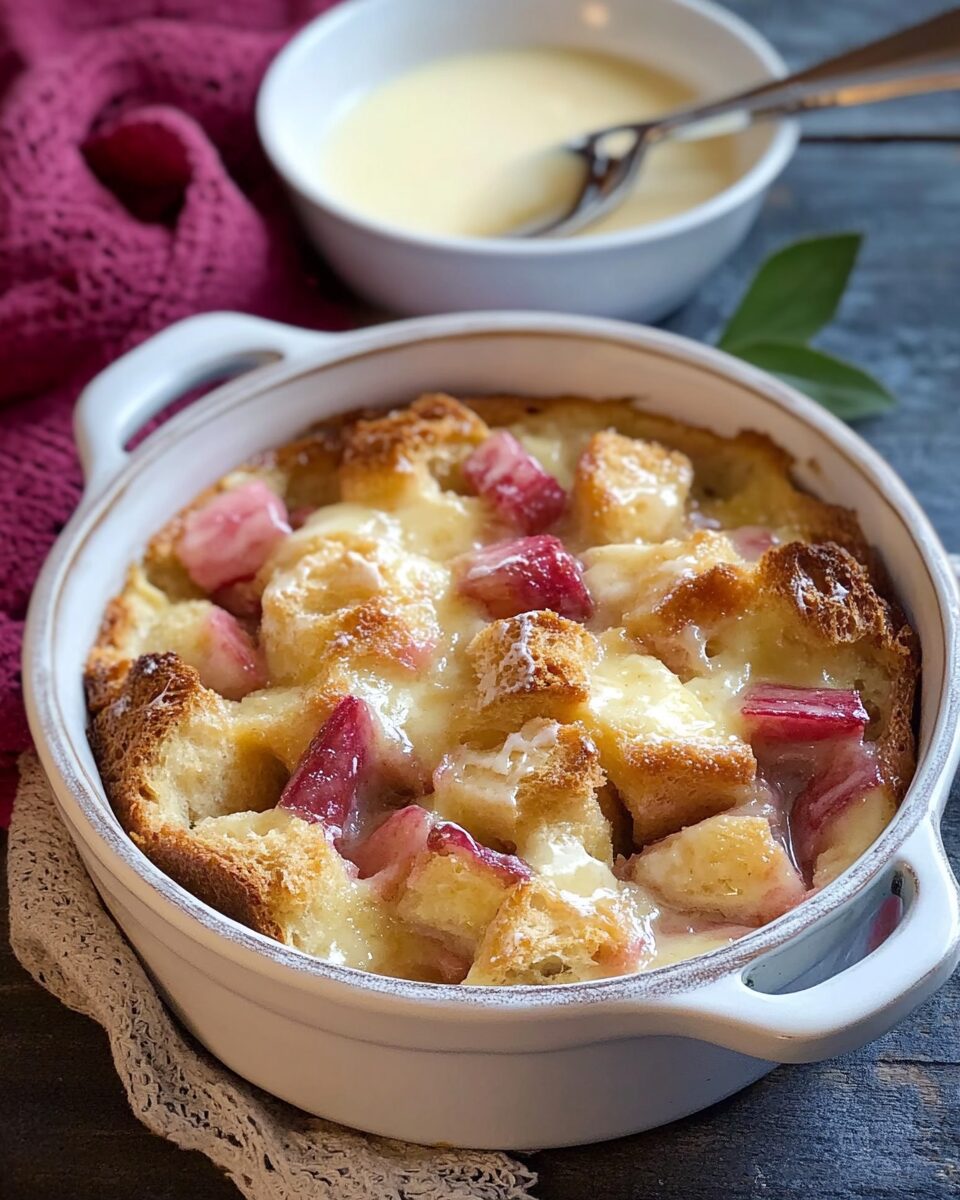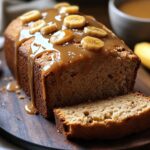A tender and rich dessert, this Rhubarb Bread Pudding is the perfect marriage of sweet and tart. The rhubarb softens during baking, releasing its signature tang into the custard-soaked bread, while the top develops a gentle golden crust.
Paired with a warm orange custard sauce that adds brightness and richness, this comforting treat is perfect for spring brunches or special dinners. It’s an old-fashioned favorite with a vibrant twist, sure to become a seasonal go-to in your kitchen.
Full Recipe
Ingredients:
For the Bread Pudding:
-
5 cups cubed day-old brioche or challah bread
-
2 cups chopped fresh rhubarb
-
3 large eggs
-
2 cups whole milk
-
1/2 cup heavy cream
-
2/3 cup sugar
-
1 tsp vanilla extract
-
Zest of 1 orange
-
1/4 tsp salt
-
Butter (for greasing the dish)
For the Orange Custard Sauce:
-
1 cup whole milk
-
1/2 cup heavy cream
-
4 large egg yolks
-
1/3 cup sugar
-
Zest of 1 orange
-
1/2 tsp pure orange extract (optional)
Directions:
-
Preheat oven to 350°F (175°C). Lightly butter a 9×9-inch baking dish.
-
Place the cubed bread and chopped rhubarb into the prepared baking dish.
-
In a large bowl, whisk together the eggs, milk, cream, sugar, vanilla extract, orange zest, and salt until well combined.
-
Pour the custard mixture evenly over the bread and rhubarb. Gently press the bread down to help it soak up the liquid.
-
Let the mixture sit for 15–20 minutes to absorb.
-
Bake in the preheated oven for 45–50 minutes, or until the pudding is puffed, golden brown, and the center is set.
-
While the pudding bakes, prepare the orange custard sauce. In a saucepan, heat the milk, cream, orange zest, and sugar over medium heat until hot but not boiling.
-
In a bowl, whisk the egg yolks. Slowly pour in some of the hot milk mixture, whisking constantly to temper the yolks.
-
Pour the tempered yolks back into the saucepan and cook over low heat, stirring constantly, until the custard thickens enough to coat the back of a spoon. Do not let it boil.
-
Stir in orange extract if using. Strain the custard through a sieve for a silky texture.
-
Serve the warm bread pudding drizzled with the orange custard sauce.
Prep Time: 20 minutes | Cooking Time: 50 minutes | Total Time: 1 hour 10 minutes
Kcal: 365 kcal | Servings: 6 servings
The Story Behind Rhubarb Bread Pudding with Orange Custard
Rhubarb bread pudding with orange custard is a dessert rooted in nostalgia and seasonal simplicity. Often regarded as a vintage favorite, this dish marries the tangy, bright flavor of rhubarb with the creamy sweetness of a rich custard. Originating from humble beginnings, bread pudding was traditionally a way to use up stale bread, transforming it into a comforting, hearty dessert. Adding rhubarb brings a tart punch that balances beautifully against the richness of the pudding, while the orange custard adds depth, a fragrant citrus note, and a touch of elegance.
Rhubarb has long been associated with spring and early summer, being one of the first vegetables to appear in gardens and markets. It’s unique in its ability to transition seamlessly from savory dishes to sweet, but it’s in baking—especially in combination with sugar and cream—where rhubarb truly shines. Bread pudding, already a canvas for customization, becomes the ideal vessel to showcase rhubarb’s vibrant flavor and color. When paired with an aromatic orange custard, the result is nothing short of extraordinary.
What Makes This Dish Special
What elevates this dish above other bread puddings is the unexpected pairing of ingredients. Rhubarb’s sour and fibrous texture softens during baking, releasing a tangy syrup that infuses the bread with its flavor. Meanwhile, the custard—a delicate blend of milk, cream, and eggs with a burst of orange zest—creates a luscious, velvety texture that cradles the bread and fruit.
Using brioche or challah bread adds another layer of luxury. These types of bread are already enriched with butter and eggs, giving the final dish a soft, almost cake-like consistency. The combination of sweet, tart, and creamy, with the added aroma of citrus, creates a dessert that feels both comforting and sophisticated.
Additionally, this recipe offers versatility. It can be served warm or cold, for brunch or dessert. Add a scoop of vanilla ice cream or a dollop of whipped cream, and it instantly becomes dinner party-worthy. Or keep it simple with a drizzle of custard and a sprinkle of orange zest for a cozy family dessert.
Culinary Technique and Sensory Experience
The culinary techniques behind this dessert are deceptively simple but highly effective. The soaking process allows the custard to fully saturate the bread, which ensures the pudding bakes evenly and remains moist throughout. The key is giving the bread enough time to absorb the liquid before it goes into the oven. This results in a texture that’s soft but not soggy, with just the right amount of firmness.
Baking the dish transforms the rhubarb into tender, ruby-red jewels nestled within the golden layers of custard-soaked bread. As it bakes, the aroma of citrus and vanilla fills the kitchen, making it a truly sensory experience. The custard sauce, cooked gently over the stovetop, requires careful attention to avoid curdling. Once complete, it delivers a silky, pourable texture that coats each bite with a whisper of orange and cream.
From the crisp edges of the bread cubes to the soft pockets of custard and the occasional burst of tart rhubarb, each bite tells a story of balance and harmony in flavors.
Health Considerations and Substitutions
Despite being an indulgent dessert, this rhubarb bread pudding can be adapted for various dietary needs. For those avoiding dairy, plant-based milk and cream alternatives work well in both the pudding and the custard. Almond milk, coconut cream, or oat milk provide richness without compromising texture or flavor. Vegan egg substitutes such as flax eggs or aquafaba can also be used with some adjustments to maintain the pudding’s structure.
Whole-grain or gluten-free bread can be substituted for traditional brioche or challah, offering more fiber and accommodating those with dietary restrictions. The sugar content, while essential for balancing rhubarb’s tartness, can be adjusted or replaced with natural sweeteners like maple syrup, honey, or stevia, depending on taste preferences.
Rhubarb is also relatively low in calories and contains dietary fiber, calcium, and antioxidants. It’s a great way to sneak in a vegetable that behaves like a fruit, especially for picky eaters.
Cultural Significance and Seasonal Appeal
Bread pudding in various forms exists across many cultures—from the British and Irish to the French and Americans. Each variation uses local ingredients and available resources. In many households, recipes were passed down through generations, often without measurements, relying instead on instinct and tradition.
In the U.K., rhubarb is a classic ingredient, traditionally harvested in late spring. The pairing of rhubarb with custard is particularly British, commonly served in crumbles and tarts. The inclusion of orange custard in this version provides a sunny, Mediterranean twist that feels refreshing and modern, all while honoring the dessert’s rustic roots.
This dish also carries strong seasonal appeal. As rhubarb is often among the first signs of warmer weather, the arrival of rhubarb desserts signals a shift toward spring and summer cooking. It’s a delightful way to celebrate seasonal produce, especially when enjoyed outdoors during brunches, garden parties, or Easter celebrations.
Serving Suggestions and Presentation Tips
To enhance the visual appeal of this dessert, consider baking it in a white ceramic or glass dish to showcase the contrast between the golden bread, pink rhubarb, and creamy custard. Garnish with fresh orange zest or candied orange peel for a pop of color and a hint of sophistication.
When serving, spoon the pudding into shallow bowls or dessert plates and drizzle the warm orange custard over the top. A dusting of powdered sugar or a few fresh mint leaves can elevate the presentation. For a more formal setting, you could portion the pudding into ramekins before baking and serve them individually with a jug of custard on the side.
You can also pair the dessert with beverages such as dessert wine, Earl Grey tea, or a citrus-forward cocktail like a mimosa. These enhance the citrusy notes in the custard and add a festive flair.
Why This Dessert Stands the Test of Time
Part of what makes rhubarb bread pudding with orange custard so beloved is its nostalgic quality. It taps into childhood memories and home kitchens, where practicality met creativity. Using leftover bread, seasonal produce, and pantry staples, this dish exemplifies the kind of cooking that’s sustainable, thoughtful, and comforting.
Yet despite its humble ingredients, the finished product feels gourmet. It’s proof that the best recipes don’t require extravagance—they require balance, technique, and love. This dessert has everything: texture, flavor, aroma, and visual appeal.
It’s also highly adaptable. Whether you’re feeding a crowd, baking for two, or prepping something in advance for a holiday meal, it scales up or down effortlessly. It can be stored in the refrigerator and reheated without losing its charm, making it a practical addition to your recipe rotation.
Conclusion
Rhubarb bread pudding with orange custard is a dish that embodies tradition and creativity in equal measure. It brings together the tart brightness of rhubarb, the cozy richness of custard-soaked bread, and the luxurious aroma of citrus. Ideal for spring gatherings or quiet evenings at home, this dessert offers comfort, sophistication, and a celebration of seasonal ingredients.
Its balance of flavor and texture ensures that it will always be met with appreciation at the table. Whether you’re a seasoned baker or a beginner in the kitchen, this recipe invites you to slow down, savor the process, and enjoy the reward—a warm, fragrant, and unforgettable dessert that feels like home in every bite.






